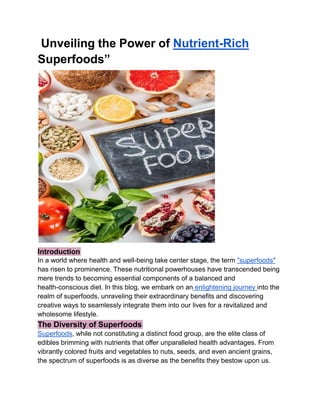Ancient grains have been gaining popularity in recent years due to their exceptional nutritional benefits and unique flavors. From quinoa and amaranth to farro and spelt, these ancient grains offer a wide range of nutrients and can be easily incorporated into your diet for a healthier lifestyle.
The Health Benefits of Ancient Grains
Ancient grains are known for their high protein, fiber, and essential nutrients content. They are also rich in antioxidants, vitamins, and minerals, making them an excellent choice for maintaining overall health. These grains are also gluten-free, making them suitable for individuals with gluten sensitivities.

Credit: issuu.com
Ways to Incorporate Ancient Grains into Your Diet
Here are some creative and delicious ways to include ancient grains in your daily meals:
1. Breakfast Ideas
Start your day with a nutritious and delicious ancient grain breakfast. Prepare a warm quinoa porridge topped with fresh fruits, nuts, and a drizzle of honey. You can also make a batch of spelt or amaranth muffins for a quick and convenient breakfast on-the-go.
2. Salad Creations
Enhance your salads by adding a variety of ancient grains such as freekeh, bulgur, or teff. These grains add a delightful texture and nutty flavor to your salads, making them more filling and satisfying. Create a colorful quinoa salad with roasted vegetables and a zesty vinaigrette for a delightful meal.
3. Side Dishes
When preparing your main dishes, consider incorporating ancient grains as flavorful and nutritious side dishes. Serve a hearty pilaf of farro and wild rice alongside your favorite protein, or mix cooked kamut with roasted vegetables for a wholesome and satisfying side.
4. Baking Alternatives
Ancient grains can be used as healthy alternatives in baking. Replace refined flours with whole grain spelt or amaranth flour to create nutritious and tasty bread, muffins, and pancakes. These grains add a delightful nuttiness and nutritional boost to your baked goods.
5. Ancient Grain Risottos And Pilafs
Elevate your culinary skills by preparing ancient grain risottos and pilafs. Use barley, farro, or freekeh to prepare a creamy and flavorful risotto, or create aromatic pilafs with a blend of quinoa, millet, and sorghum. These dishes offer a unique twist on traditional rice-based recipes.

Credit: www.slideshare.net
Where to Find Ancient Grains
Ancient grains are widely available in grocery stores, health food stores, and online retailers. Look for organic and non-GMO options to ensure you are getting the highest quality grains for your meals. Be sure to check the labels for cooking instructions and nutritional information for each type of grain.
By incorporating ancient grains into your diet, you can enjoy a wide range of flavors, textures, and nutritional benefits. Experiment with different grains and recipes to discover new and exciting ways to incorporate these ancient treasures into your meals. Whether it’s a hearty salad, a comforting bowl of porridge, or a flavorful pilaf, ancient grains offer endless possibilities for creating nourishing and satisfying meals.
Frequently Asked Questions For How To Incorporate Ancient Grains: Unleash The Power Of These Nutrient-rich Superfoods
How Can I Incorporate Ancient Grains Into My Diet?
Incorporating ancient grains into your diet is easy! You can use them as a substitute for regular grains in your favorite recipes. Try adding quinoa or amaranth to your salads, or using farro or spelt in place of rice or pasta.
Experiment with different ancient grains to add variety to your meals and reap the health benefits they offer.
What Are The Health Benefits Of Ancient Grains?
Ancient grains are packed with nutrients that can benefit your health. They are rich in fiber, which aids digestion and helps you feel full for longer. They also contain a range of vitamins and minerals, including iron, magnesium, and B vitamins.
Consuming ancient grains regularly can promote heart health, regulate blood sugar levels, and support a healthy weight.
Are Ancient Grains Gluten-free?
Not all ancient grains are gluten-free, but there are some options for those with gluten sensitivities. Grains like quinoa, amaranth, and buckwheat are naturally gluten-free and can be enjoyed by individuals with celiac disease or gluten intolerance. However, it’s important to check labels and ensure that the products you purchase are certified gluten-free to avoid any cross-contamination.
How Do Ancient Grains Compare To Modern Grains?
Ancient grains differ from modern grains in several ways. They have undergone minimal processing and have retained their natural nutritional profiles. Ancient grains usually have higher fiber content, making them more filling and beneficial for gut health. They also tend to be richer in vitamins and minerals compared to heavily processed modern grains.
Adding ancient grains to your diet can be a great way to incorporate nutrient-dense foods into your meals.
